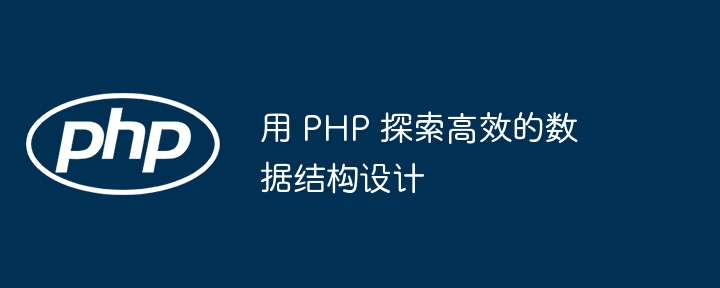Explore efficient data structure design with PHP
The data structures in PHP cover four types: array, linked list, stack and queue, each of which is suitable for different application scenarios. Array: Linear structure used to store values of the same type, efficient search and insertion. Linked list: A data structure with node connections, efficient for insertion and deletion. Stack: Follow the LIFO principle and follow the last in first out. Queue: Follow the FIFO principle and follow first-in, first-out. In e-commerce applications, arrays are suitable for storing shopping basket items because they are fast to find and retrieve.

Explore efficient data structure design using PHP
In software development, choosing the appropriate data structure is crucial to improving the performance of the application. Efficiency is crucial. PHP provides a rich set of data structures, including arrays, linked lists, stacks, and queues.
Array
An array is a linear data structure used to store values of the same data type. They are very efficient in search and insertion operations. Arrays can be created using the following syntax:
$array = array(1, 2, 3, 4, 5);
Linked list
A linked list is a linear data structure that consists of nodes, each node containing data and pointing to the next Pointer to the node. Linked lists are very efficient in insertion and deletion operations. A linked list can be created using the following syntax:
class Node {
public $data;
public $next;
}
$head = new Node();
$head->data = 1;
$head->next = new Node();
$head->next->data = 2;
$head->next->next = new Node();
$head->next->next->data = 3;Stack
The stack is a restricted linear data structure that follows the last-in-first-out (LIFO) principle. This means that the last element added will be removed first. A stack can be created using the following syntax:
class Stack {
private $stack;
public function push($data) {
$this->stack[] = $data;
}
public function pop() {
return array_pop($this->stack);
}
}Queue
A queue is a restricted linear data structure that follows the first-in, first-out (FIFO) principle. This means that the elements added first will be removed first. A queue can be created using the following syntax:
class Queue {
private $queue;
public function enqueue($data) {
$this->queue[] = $data;
}
public function dequeue() {
return array_shift($this->queue);
}
}Practical case
Consider an e-commerce application that needs to store items in a shopping basket. Using arrays makes it easy to manage items because items can be quickly found and retrieved based on an index.
$shoppingCart = array(); // 添加商品 $shoppingCart[] = "商品 1"; $shoppingCart[] = "商品 2"; $shoppingCart[] = "商品 3"; // 检索商品 echo $shoppingCart[0]; // 输出: "商品 1"
Using appropriate data structures can significantly improve the performance and efficiency of your application. PHP provides a rich set of data structures that can be selected based on the needs of a specific application.
The above is the detailed content of Explore efficient data structure design with PHP. For more information, please follow other related articles on the PHP Chinese website!

Hot AI Tools

Undresser.AI Undress
AI-powered app for creating realistic nude photos

AI Clothes Remover
Online AI tool for removing clothes from photos.

Undress AI Tool
Undress images for free

Clothoff.io
AI clothes remover

AI Hentai Generator
Generate AI Hentai for free.

Hot Article

Hot Tools

Notepad++7.3.1
Easy-to-use and free code editor

SublimeText3 Chinese version
Chinese version, very easy to use

Zend Studio 13.0.1
Powerful PHP integrated development environment

Dreamweaver CS6
Visual web development tools

SublimeText3 Mac version
God-level code editing software (SublimeText3)

Hot Topics
 CakePHP Project Configuration
Sep 10, 2024 pm 05:25 PM
CakePHP Project Configuration
Sep 10, 2024 pm 05:25 PM
In this chapter, we will understand the Environment Variables, General Configuration, Database Configuration and Email Configuration in CakePHP.
 PHP 8.4 Installation and Upgrade guide for Ubuntu and Debian
Dec 24, 2024 pm 04:42 PM
PHP 8.4 Installation and Upgrade guide for Ubuntu and Debian
Dec 24, 2024 pm 04:42 PM
PHP 8.4 brings several new features, security improvements, and performance improvements with healthy amounts of feature deprecations and removals. This guide explains how to install PHP 8.4 or upgrade to PHP 8.4 on Ubuntu, Debian, or their derivati
 CakePHP Date and Time
Sep 10, 2024 pm 05:27 PM
CakePHP Date and Time
Sep 10, 2024 pm 05:27 PM
To work with date and time in cakephp4, we are going to make use of the available FrozenTime class.
 CakePHP File upload
Sep 10, 2024 pm 05:27 PM
CakePHP File upload
Sep 10, 2024 pm 05:27 PM
To work on file upload we are going to use the form helper. Here, is an example for file upload.
 CakePHP Routing
Sep 10, 2024 pm 05:25 PM
CakePHP Routing
Sep 10, 2024 pm 05:25 PM
In this chapter, we are going to learn the following topics related to routing ?
 Discuss CakePHP
Sep 10, 2024 pm 05:28 PM
Discuss CakePHP
Sep 10, 2024 pm 05:28 PM
CakePHP is an open-source framework for PHP. It is intended to make developing, deploying and maintaining applications much easier. CakePHP is based on a MVC-like architecture that is both powerful and easy to grasp. Models, Views, and Controllers gu
 How To Set Up Visual Studio Code (VS Code) for PHP Development
Dec 20, 2024 am 11:31 AM
How To Set Up Visual Studio Code (VS Code) for PHP Development
Dec 20, 2024 am 11:31 AM
Visual Studio Code, also known as VS Code, is a free source code editor — or integrated development environment (IDE) — available for all major operating systems. With a large collection of extensions for many programming languages, VS Code can be c
 CakePHP Creating Validators
Sep 10, 2024 pm 05:26 PM
CakePHP Creating Validators
Sep 10, 2024 pm 05:26 PM
Validator can be created by adding the following two lines in the controller.






